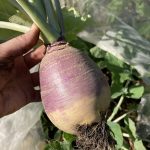- If planted in spring/summer, they should be ready to harvest in autumn – wait until they get nice and big! You’ll be able to see the crowns above the soil so it is easy to tell when they are the right size.
- If planted in autumn, you can expect to be able to harvest in early spring.
- You can store them in a cool dark place (in a sand box is best.)
- Or you can leave swede in the ground until you want to use it.
How to grow... Swede
Rocket Growing Guides

Swede is easy to grow and stores well too. It is a great veg for stews and casseroles, and you can eat the leaves too (which not many people do simply because they don’t know that they can).
- Swede Growing Guide
How to Plant Swede
- Swedes like a light fertile loam but will grow in most soils. Choose a nice sunny site.
- Raised beds or planting into the ground works best for growing swede. but you could also plant into fairly deep, rectangular planters or wide pots.
- Plant 30cm apart
- In areas of heavy rainfall plant your seedlings in ridges to help with drainage. Otherwise plant on flat ground which has been well worked and consolidated.
How to Grow Swede
- It is good to cover swede plants with horticultural fleece – this will help to keep many pests off your plants (see below!) – just drape it gently over the plants and secure at sides and corners with heavy stones.
- Keep well watered during dry spells, trying to avoid periods of drought and very dry soil.
- Keep weeds down – an onion hoe is good for getting in between plants – be careful not to disturb the crown of the swedes
- Watch out for slugs and snails while plants are young
Common Pests & Problems with Swede
Swedes are part of the brassica family, and suffer from the same pests/diseases:
- Flea Beetle – lots of tiny pin-prick holes in the leaves is a sure sign of flea beetle. Try to keep plants well watered to avoid the soil becoming dry, and keep plants covered with fleece/mesh.
- Cabbage root fly – these flies often lay their eggs at the base of brassica plants. When the maggots hatch they burrow into the roots and eat through your beloved plants! Keep plants covered with horticultural fleece to avoid this.
- Caterpillars – cabbage butterflies will lay their eggs on the leaves of brassicas. When they hatch, the caterpillars will rapidly eat the leaves. It is best to cover swede plants with fleece/mesh netting to prevent this. If you do find caterpillars or eggs, wipe them off asap.
- Pigeons – pigeons love brassica leaves – it is best to net your crops!
- Slugs & Snails – these will happily chew through swedes. Be sure to protect crops with slug traps, grit etc.


